Ayurvedic Healthy Daily Routine Charak Samhita Sutrasthana – Chapter 5
The fifth chapter of Charak Samhita Sutrasthana deals with Ayurvedic dietetics, the right quantity of food in relation to digestion strength, personal hygiene, herbal smoking, nasal drops, oral hygiene, gargling, head massage, foot massage, etc. The chapter name is Matrashiteeya Adhyaya.
There are two objectives of Ayurveda.
1. Treatment of patients suffering from diseases and
2. Maintenance of positive health.
In the first four chapters, and in the next four chapters, various ways of maintenance of normal health are described. Of all the factors for the maintenance of positive health, food taken in proper quantity occupies the most important position. So the first topic of this chapter deals with the quantity of foods to be consumed.
Table of Contents
Shloka recitation video

One should eat in proper quantity. The quantity of food to be taken depends upon digestion strength. (3) For proper maintenance of health.
Quantity of food and digestion
The amount of food, which, without disturbing the equilibrium of Doshas and Dhatus (Anupahrutya prakruti), gets digested and metabolised in proper time (Yatha kaalam jaraam gacchati), should be regarded as the proper quantity.(4)
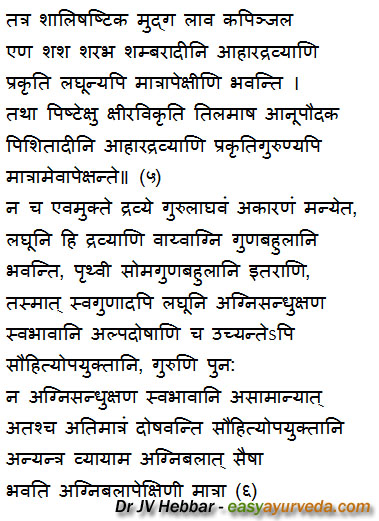
Laghu and Guru Ahara
Laghu (easy to digest) and Guru (heavy to digest) types of foods –
Food items like rice, Shashtika (a variety of rice that matures in 60 days) , green gram, common Quail, Grey Partridge, antelope, rabbit, Wapiti, Indian sambar deer etc – are light in nature and easy to digest. Easiness in digestion should be understood according to the quantity of the food.
A light to digest (laghu) food in very high quantity might become hard to digest (Guru), Similarly preparations of flour, sugarcane and milk, Sesame, black gram and meats of marshy and aquatic animals even though heavy in digestion by nature are also required to be taken in proper quantity.
But it should not be concluded that the description of heaviness or lightness does not carry any importance. Because, the light food articles are predominant in the qualities of air and fire elements and heavy food articles in Prithvi and Ap (earth and water elements).
Therefore, according to their qualities, the light articles of food, being stimulants of appetite and by nature are considered to be less harmful even if taken in excess. On the other hand, heavy articles of food suppress appetite. They are harmful if taken in excess unless there is a strong powder of digestion and metabolism achieved by physical exercise. Thus the quantity of food depends upon the power of digestion. (5-6). By nature light food is said to be conducive to good health. Heavy food on the other hand is considered to be detrimental. But for both the types of food, if quantity is to be taken into account, lightness and heaviness of food do not seem to have any implication. Thus, it is true that the quantity rather than the heaviness / lightness of food is important in the present context.
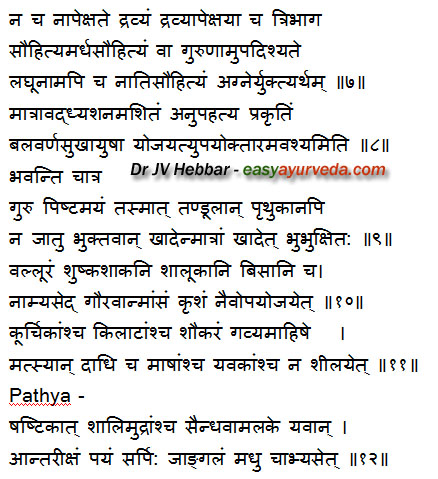
Quantity of food in relation with stomach volume
We have learnt that the right quantity of food depends on the quality of food. If the food is heavy, only one third or half of the stomach capacity is to be filled up, even in the case of light food articles excessive intake is not conducive to the maintenance of the power of digestion and metabolism. (7)
Importance of food taken in proper quantity
Taken in appropriate quantity, food certainty helps the individual in bringing about strength, complexion, happiness and longevity without distributing the equilibrium of Dhatus (body tissues) and Doshas of the body .(8) Thus it is said – After having taken food, one should never take such heavy articles like pastries, rice, Pruthuka (boiled and Flattened rice). Even when hungry one should take these articles only in proper and limited quantity (9)
Contraindicated foods
One should not regularly take heavy food items such as Vallura (dried meat), dry vegetables, lotus rhizomes and lotus stalk. One should never take meat from a diseased animal. One should not regularly take Kurchika (Boiled Buttermilk) , Kilata ( A sweet milk product), pork, beef, Buffalo meat, fish, curd, Masha (Black gram) and Yavaka (a variety of Barley). (10-11)
Pathya foods – Indicated foods
One should regularly take Shashtika (a kind of rice harvested in sixty days), Shali (rice), Mudga – green gram – Averrhoa carambola, Rock salt, Amalaki (Amla).
Rain water, ghee, Meat of animals dwelling in arid climate and honey (12) One should regularly take such articles which are conducive to the maintenance of good health and are capable of preventing the attacks. Over-dosage or longer period than prescribed may cause diseases. (13)
Anjana – Collyrium
Personal hygiene : Hereafter collyrium (Kajal) etc daily activities of personal hygiene are explained. (14)
Anjana – Collyrium – Kajal
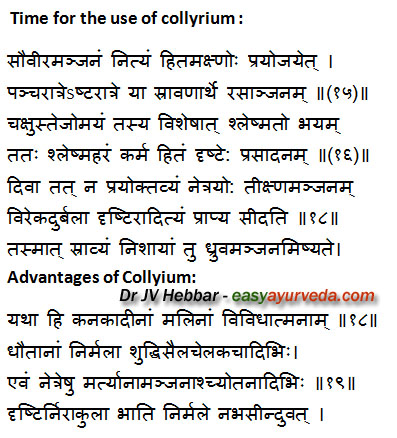
One should regularly apply the collyrium made of antimony because it is useful for the eyes. Rasanjana – Aqueous extract of Berberis aristata (a preparation of Berberis aristata DC.) is to be applied once in every 5-8 nights to produce lacrimation of the eyes. Of all the Mahabhutas, Tejas (Fire, in the form of light) dominates in the composition of eyes; so they especially are susceptible to kapha. Therefore, the therapy (collyrium etc) which alleviates kapha is good for keeping the vision clear. A strong collyrium must not be applied to the eyes during the day time as the eyes weakened by drainage will be adversely affected at the sight of the Sun. Thus, the collyrium meant for draining should be applied only during night. (15- 17)
As different types of tarnished gold ornaments are spotlessly cleared by means of oil, cloth and brush, so also by the use of Collyrium and eye drops, the eyes become spotlessly bright like the moon in a clear sky. (18-19)
Dhumapana – Herbal smoking
Harenua (Pisum sativum Linn), Priyangu – Callicarpa macrophylla Vahl. Prithvika ( Nigella sativa Linn), Keshara ( Mesua ferrea Linn), Nakha – Capparis sepiaria, Hrivera (Pavonia odorata Willd), Sandalwood, Patra ( Cinnamomum tamala Nees and Eberum ), cinnamon, cardamom, Usheera – Vetiver, Padmaka – Wild Himalayan Cherry – Prunus cerasoides Dhyamaka (Cymbopogon schoenathus Spreng ), Licorice, Mamsi – Nardostachys jatamansi, Guggulu (Commiphora mukul Engl.), Aguru (Aquilaria agallocha Roxb. ), sugar, bark of Nyagrodha (Ficus benghalensis Linn), Udumbara (Ficus racemosa Linn), Ashvattha (Ficus religiosa Linn), Plaksha (Ficus lacor Bunh- Ham), and Lodhra (Symplocos racemosa) Vanya (Cyperus tenuiflorus), Sarjarasa (Resin of Vateria indica Linn). Musta (Cyperus rotundus) Shaileya (Permellia perforta), Kamala (Nelumbo nucifera Gaertn), Utpala (Nymphaea alba), Shrivestaka (resinous extract from Pinus roxburghii Sargent ), Shallaki (Boswellia serrata Roxb.), Sukararha .
All these drugs should be ground, made a paste and applied to a reed, and then made into a cigar of the shape of a barley grain having central thickness of a thumb and length of eight fingers breadth. It should then be dried up and the reed be taken out of it; With the help of a pipe, one should regularly smoke that cigar after smearing it with some unctuous substance and lighting it . This is altogether harmless (20-24)
One should smoke unctuous cigars made of useful drugs of sweet taste along with fat of muscle, ghee and bee wax according to the prescribed method. (25)
For the elimination of Doshas from the head, smoking of cigars made of Shveta (white variety of Clitoria ternatea Linn), Jyotishmati (Celastrus paniculatus Wild). Orpiment, regular and other fragrant articles like Agaru (Aquilaria agallocha Roxb), Patra – Cinnamomum tamala Nees and Eberum. etc. is prescribed (26)
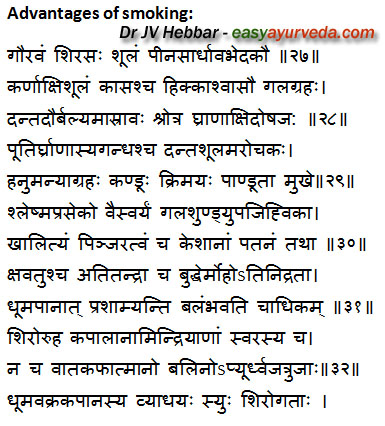
Health benefits
Health benefits of herbal smoking: Smoking relieves heaviness of head, headache, Rhinitis, Migraine, Earache, Pain in eye, Cough, hiccup, Dyspnoea, Obstruction in throat, weakness of teeth, morbid discharge from the ear, nose and eye, purulent smell from nose and mouth toothache, Anorexia, Lock jaw, Torticollis, Pruritus, infective condition, pallor of face, excessive salivation, impaired voice, Tonsillitis, uvulitis, Alopecia, greying of hair, falling of hair, sneezing, excessive drowsiness, loss of consciousness, and excess sleep. It also strengthens hair, skull bones, sense organs and voice. The diseases pertaining to head and neck arising out of Vata and Kapha do not affect the person who is used to smoking (27- 32)
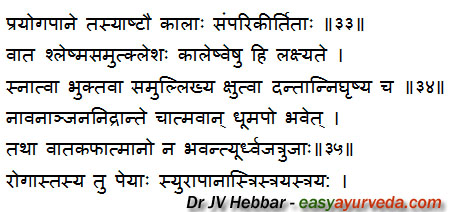
Schedule for smoking
Eight timings are prescribed for habitual smoking because Vata, Pitta and Kapha get vitiated during these times – after bathing, after eating, after tongue scraping, after sneezing, after brushing the teeth, after Nasya, after application of collyrium and after sleep. Herbal smoking at these timings prevents diseases of head and neck resulting from the vitiation of Kapha and vata, Smoking is to be done thrice- three puffs each at a time. (33-35)
During the prescribed times, a wise person should smoke twice for habitual variety of smoking (Prayogika), once for unctuous variety (Snaihika) and three to four times for the elimination variety (Vairechanika) of smoking. (36)
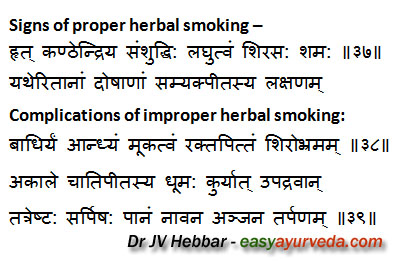
Signs of proper herbal smoking
Clarity of mind, throat and sense organs, lightness of head and elimination of the above mentioned Doshas are features of proper herbal smoking (37)
Complications of improper herbal smoking
If untimely done or overdone, smoking causes such troubles as deafness, blindness, dumbness, bleeding from different parts of the body and giddiness. (38)
Treatment of complications
If such troubles due to untimely and over smoking arise, intake of ghee, administration of nasal drops, collyrium and demulcent drinks are prescribed. These should be prepared with unctuous drugs in the event of vitiation of Vayu associated with Pitta, with cooling drugs in case of Raktapitta, and with arid drugs in Kapha and Pitta imbalance. (39-40)
Contraindications for herbal smoking
A person after undergoing emesis (vamana), purgative (virechana) or enema (Basti), a person having bleeding through different orifices of the body, one afflicted with toxins or a grief- stricken person should not smoke, a pregnant woman should also refrain from smoking; similarly one should not smoke when he is fatigued or intoxicated. Smoking is also prohibited in the event of vitiation of digestion and metabolism, vitiation of Pitta, fainting, giddiness, excess thirst and phthisis. One should not smoke after having taken liquor, milk, fatty substances, honey or curd; nor should one smoke when there is roughness in his body or he is enraged. Smoking is also prohibited in the event of dryness of palate, fainting, injury to the head, Shankhaka (a type of headache in the temporal region marked by excessive pain and swelling – Usually killing a patient in three days), diabetes and narcosis. One who, out of ignorance, smokes in contravention of these situations, subjects himself to various serious diseases. These diseases become severe due to the adverse effect of improper smoking. (41-45)
Routes of smoking
One for whom smoking is prescribed should smoke through the nose, in diseases of head, nose and eyes. One should exhale through the mouth but if one smokes through the mouth, he should not exhale through the nose because the smoke moving in the reverse direction instantaneously affects the eyes. (46-47)
Method of herbal smoking
With the body erect, eyes looking forward, mind concentrated and having self-control, one should sit at ease and smoke three times, thrice during each time, through one nostril while closing the other one. (48)
For the elimination type of smoking (Virechana Dhumapana), the length of the pipe should be 24 finger breadth; for unctuous smoking (Snaihika), of 32 finger breadth; For habitual smoking (Prayogika), 36 (finger breadth is to be measured with one’s own finger). [49]
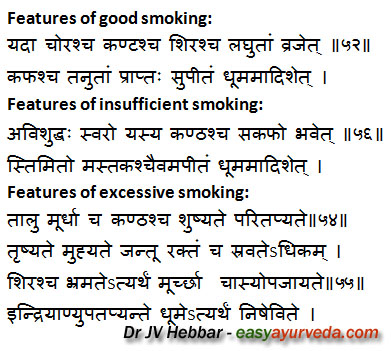
The best pipe is the one which is straight, having three knots, whose mouth is the size of the seed of a Kola fruit (Zizyphus jujube Lam) and which is made of the same material as that of the enema pipe. [50] The smoke used according to the prescribed dose and time does not affect the sense organs as it is not inhaled directly. It is interrupted by knots and is attenuated by its flow through the passage of the pipe. [51]
Samyak Yoga Lakshanas
Signs like lightness of the chest, throat, head and liquification of Kapha are the features of correct smoking. [52]
Ayoga Lakshanas
Ayoga – Signs of insufficient smoking – Impairment of voice, presence of Kapha (phlegm) in the throat and heaviness of head are the features of insufficient smoking. [53]
Atiyoga Lakshanas
Atiyoga – If one smokes in excess, his palate, head and throat get dried up and become hot. One feels thirsty and he becomes unconscious; there may be excessive bleeding, dizziness. fainting and hotness in sense organs. [54-55]
Nasya – Nasal Drops
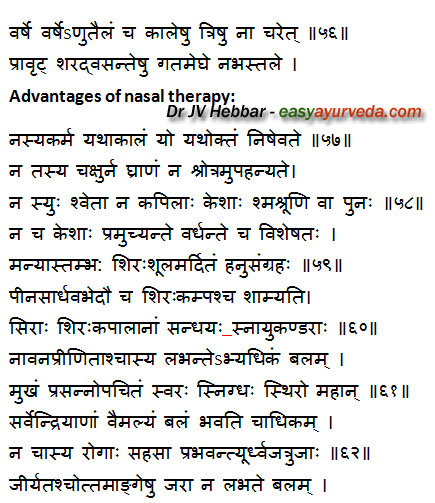
Nasal drops – One should use “Anu taila” every year during the three seasons, viz the rainy season, the autumn and the spring, when the sky is free of clouds. [56]
Benefits of nasal drops
One who practises nasal therapy in time according to the prescribed method, his eyes, nose and ears are not affected by any morbidity. His hair and head never become white or grey; he never experiences hair fall; those rather grow luxuriously. Diseases like torticollis, headache, facial paralysis, lock jaw, rhinitis, migraine and tremors of the head are cured thereby. Being nourished by inhalation, his veins, joints, ligaments and tendons of head and neck gain greater strength. His face becomes cheerful and plump; and his voice becomes sweet, stable and stertorous. All the sense organs become clear and attains considerable strength. Diseases relating to the head and neck do not attack such a person. Even though he might be growing old, old age does not affect his head (in the form of grey hair etc). [57]
Preparation of Anu taila
Sandalwood, Aguru (Aquilaria agallocha Roxb), Patra – Cinnamomum tamala Nees and Eberum., Bark of Darvi (Sida cordifolia Linn), Prapaundarika (Nymphaea stellata), Sookshma Ela – cardamom, Vidanga (Embelia ribes), Bilva (Aegle marmelos), Utpala (Nymphaea alba), Hrivera (Pavonia odorata), Abhaya – Terminalia chebula, Usheera – (Vetiveria zizanioides), Vanya (Cyperus tenuiflorus), cinnamon, Musta (Cyperus rotundus), Sariva – Indian Sarsaparilla – Hemidesmus indicus, Sthira – Desmodium gangeticum, Jivanti – Lep, Prishnaparni – Uraria picta (Uraria Picta), Suradaru (Cedrus deodara), Shatavari (Asparagus racemosus), Harenu (Pisum sativum), Brihati – Solanum indicum , Vyaghri (Solanum xanthocarpum), Surabhi (Pluchea lanceolata), Padmakesara (Filaments of Nelumbo nucifera). These drugs should be boiled with hundred times of pure rainwater (of the oil in quantity), till it is reduced to ten times of the oil (in quantity). The oil should be boiled in that decoction for ten times. At the final (that is the tenth) stage of boiling, an equal quantity of goat’s milk should be added to it. This is the prescribed method for preparing Anu Taila which is useful for inhalation. The prescribed dosage of oil is half Pala or 24 ml (this is the quantity to be used in twenty-four hours).
Nasal drops administration
After a head massage with oil and sweating therapy, Anu Taila is to be administered into the nostril with the help of a cotton swab on alternate days- thrice daily- for seven days. This is useful in alleviating all the Tridosha and gives strength to the sense organs. The benefit of this oil as envisaged above can be derived if it is used in proper time. The patient using it should reside in a place which is neither too windy nor too warm, he should take wholesome food and have self-control. [63-70]
Teeth brushing
One should use the tooth-cleaning stick whose end is crushed and which is either astringent, pungent or bitter in taste. This should be done in such a way that the gums are not affected. This removes the foul smell and tastelessness. It removes the dirt on the tongue, teeth and mouth. It improves taste. This cleans the teeth instantaneously. [71-72]
Plants for dental brush
Karanja (Pongamia pinnata Merr), Karavira (Nerium indicum Mill), Arka – (Calotropis gigantea R.Br.ex Ait), Malati (Aganosma dichotoma K. Schum), Kakubha (Terminalia arjuna W.&A), Asana (Terminalia tomentosa W.&A)- these and other trees having identical properties are recommended as toothbrush. [73]
Tongue scraping
Tongue scrapers, which should not be sharp edged and are curved, are to be made of metals like gold, silver, cropper, tin and brass. [74]
The dirt deposited at the root of the tongue, obstructs expiration and gives rise to foul smell; so the tongue should be scraped regularly.[75]
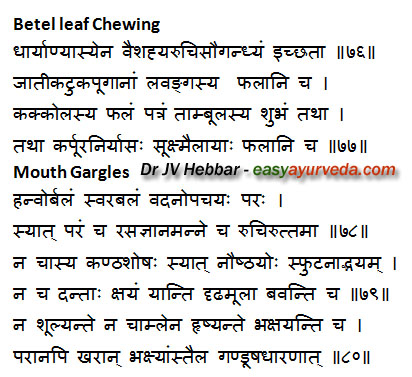
Betel leaf chewing
One desirous of clarity, taste and good smell of mouth should chew the fruits of nutmeg, clove, Kauka (Hibiscus abelmoschus Linn), Puga (Areca catechu Linn), Kakkola (Piper cubeba Linn), lesser cardamom, flower stalk of Tambula (Piper Betle Linn).and the extract of camphor. [76-77]
Gargling
Sesame oil gargling is beneficial for the strength of jaws, depth of voice, flabbiness of face, excellent gustatory sensation and good taste for food. One will never get dryness of throat, nor does his lips ever get cracked; his teeth will never develop caries and will be deep-rooted; he will not have any toothache nor will his teeth set on edge by sour intake; his teeth can chew even the hardest eatables [78-80]
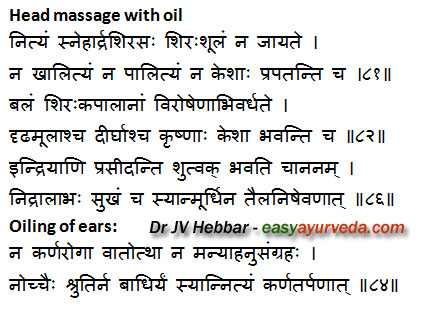
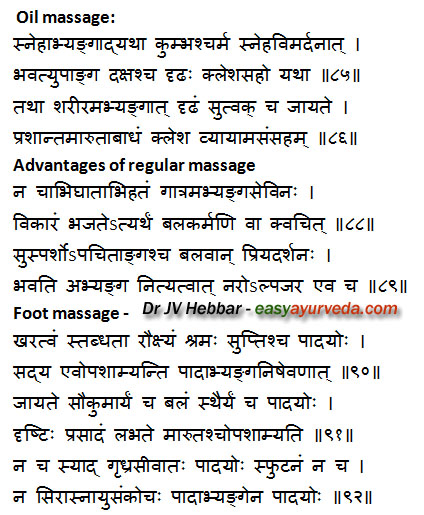
Head massage
One who applies sesame oil on his head regularly does not suffer from headache, baldness, greying of hair, nor do this hair fall. Strength of his head, forehead is specially enhanced; his hair becomes black, long and deep-rooted; his sense organs work properly; the skin of his face becomes brightened; applying sesame oil on the head produces sound sleep and happiness. [81-83] Ear diseases due to vitiated Vata, torticollis, lock jaw, difficulty of hearing and deafness are prevented if oil is regularly dropped into the ears. [84]
As a picture, a dry skin, and an axis (of a cart) become strong and resistant by the application of oil, so by the massage of oil the human body becomes strong smooth-skinned; it is not susceptible to the diseases due to Vata; it is resistant to exhaustion and exertions. [85-86]
Vata dominates in the tactile sensory organ, and this sensory organ is lodged in the skin. The massage is exceedingly beneficial to the skin; so one should practice it (oil massage) regularly. [87]
Advantages of regular massage
In the one who practices oil massage regularly, the body, even if subjected to injuries or strenuous work, is not much injured; His physique is smooth, not flabby, strong and charming. By regular oil massage, the onslaught of ageing is slackened. [88-89]
Foot massage
By massaging oil on the feet, roughness, immobility, dryness, tiredness and numbness are instantaneously cured; Tenderness, strength and steadiness of feet are improved. The eye sight becomes clear and vitiated Vata is relieved. Prevention from sciatica, cracking of feet, constriction of vessels and ligaments of feet is ensured by foot massage with oil. [90-92]
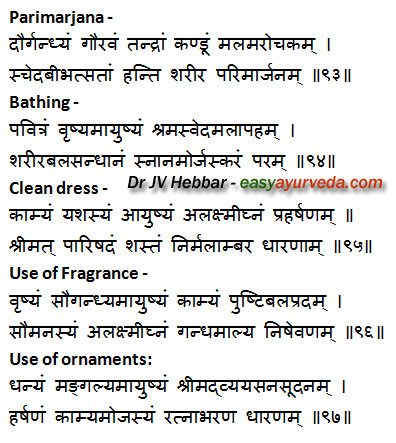
Parimarjana
Parimarjana – applying cream / paste over the body – Applying herbal creams over the body eliminates bad smell, cures heaviness, drowsiness, itching and removes undesirable dirt and unpleasantness due to sweating. [93]
Effects of bathing
Bathing is purifying, improves sexual strength, stimulant and life-giving; removes fatigue, sweating and dirt, it brings about strength in the body and is an aid par excellence for the enhancement of Ojas. [94]
Role of clean dress in life
Wearing clean apparel adds to the bodily charm, reputation, longevity and prevents bad luck. It brings about pleasure, grace, competence to participate and good looks. [95]
Use of fragrance
Use of scents and garlands stimulates libido, produces good smell in the body, enhances longevity and charm; it gives corpulence and strength to the body; it is pleasing to the mind and it prevents bad luck.[96]
Use of ornaments
Wearing of gems and ornaments adds to the prosperity, auspiciousness, longevity, grace, prevents dangers from snakes, evil spirits etc. It is pleasant and charming. It is also conducive to Ojas [ 97]
If one frequently cleans the feet and excretory orifices (with water, earth etc), it promotes intelligence, brings about purity, cleanliness and longevity; it also eliminates bad luck and the bad effects of Kali (i.e age of vice MW). [98]
Care for hair and nails
The dressing and cutting of hair, beard (including moustache) and nails, etc. adds to the corpulence, libido, longevity, cleanliness and beauty. [99]
Use of foot wears
Use of footwear is conducive to eyesight and skin (of feet); it protects the feet from reptiles, etc. it gives strength and facilities the display of physical force and is libidinal stimulant. [100]
Use of hand stick
The use of a walking stick prevents slipping, and averts the enemy; it gives strength and longevity; it averts fear (of the attacks of reptiles etc). [102]
Simile on personal vigilance
A wise person should be vigilant about his duties towards his own body like an officer- in-charge of a city and a charioteer towards the city and the chariot respectively. [103]
Thus it is said: One should adopt only such means of livelihood which does not clash with the virtuous path. One should follow the path of peace and engage himself in studies. This is how one can attain happiness.[104]
To sum up:- Quantity of food, articles of food, quantity of food with reference to their heaviness and lightness, such as the diets which are permitted and those which are prohibited, collyrium, herbal smoking, its three types, the advantages of smoking, its timings and frequency of use, signs of complications and their treatment, individuals for whom smoking is prohibited, the manner of smoking, the materials which the cigar pipe is made of, different varieties of pipes for different categories of smoking, the therapeutic properties of nasal therapy, the procedure, the therapy that should be used, the manner in which it is to be used and its timings; how and what kind of tooth cleaning stick is to be used and their individual properties, the drugs that are to be kept in the mouth for chewing purpose; therapeutic utility of oil gargle, the benefits of applying oil on the head; benefits of instillation oil into ears, massage, oil massage of the feet, unction, bathing, wearing of clean apparel, shaving and cutting of hair, use of foot wear, umbrella and walking stick- all these are described in this chapter entitled “Matrasitiya, i.e Quantitative of Dietetics “. [105-111]
Thus ends the fifth chapter on “Quantitative Dietetics” of Sutrasthana of Agnivesha’s work as redacted by Charaka.











28 comments
Vijaya kamalapurkar
Completely informative and useful book about tridoshas,diet,massaging methods,aroma therapy,etc. etc…
tarun
Can never follow all this stuff sir. Will never read Charak Sanhita or Ashtang Hridayum. I don’t see the need of reading all of this. If one wants to become an Ayurvedacharya then it’s fine but I don’t have any intentions of doing so. Will read only that much which is required for my benefit. The volume of food taken should be 2/3rd of the amount of food that can fill you up. Suppose one can eat 3 chapattis then it’s better to have only 2 chapattis.
caroline
Thank you so much for this article! I am really interesting in this and gets so many explanations why to do all this.
Dr J V Hebbar MD(Ayu)Author
I think Acharya Agnivesha and Acharya Charaka should be thanked. 🙂
Dhara
Thank you so much for all this informative articles. I have one que: is it true that we should clean our tongue only once a day, in the morning upon waking up? Is it harmful to clean during the day? What kind of harm does that bring? Can you plz explain in detailed! Is it explained in any ancient Ayurveda books?
Dr J V Hebbar MD(Ayu)Author
As per this chapter itself, tongue cleaning is a highly recommended habit. So, I do not find any wrong in cleaning it twice a day.
lakshmikanth
hi
this is very good and useful to every body to follow exact dinacharya; which gives health and prosporous.
thanks,
Lakshmikanth
Dr J V Hebbar MD(Ayu)Author
Thanks.
Monique
Fantastic article. Q1. Which is better, sesame oil vs amla oil for hair. 2. Sesame for gargling, wold that be the sesame for cooking or for massage oil? What would you suggest? 3. Oil drop in ear, what kind and how much, how often? Your articles have helped me tremendously. I keep coming back for more.
Dr J V Hebbar MD(Ayu)Author
Amla oil is better than sesame oil for hair.
Edible (cooking) sesame oil can be used for gargling / oil pulling.
2 drops for each ear. But for this, the oil should be very genuine and sterile.
Monique
Please tell me what is vitiated vata?
Dr J V Hebbar MD(Ayu)Author
Vitiated means increased.
aditi
how to consume betel leaves?? with its midrib or not? coz our ancestors used to take it by plucking the midrib
plzz let us know…
Dr J V Hebbar MD(Ayu)Author
Without midrib.
Dr J V Hebbar MD(Ayu)Author
Will write soon. Thanks.
P
Sir ,
The Mudga – green gram mentioned in this article, is it same as commonly available mung dal ? or is it different ?
mung beans looks quite large in size whereas mung dal is small in size
do they have same benefits.. ?
thanks
Dr J V Hebbar MD(Ayu)Author
Mudga is considered as green gram. Beans and dal both have similar benefits.
Satya Pal Narang
Excellent summary particularly for those who do not know good Sanskrit. spnarang
nilambara
Indeed Su 5.10-11 mentions yavaka is contraindicated, but doesn’t 5.12 include among the foods to eat regularly, yava?
Dr J V Hebbar MD(Ayu)Author
Yavaka is inferior version and is different than Yava
nilambara
Indeed. But your list of foods in Su 5.13 doesn’t include yava. I also don’t remember averrhoa carambola being mentioned.
Do you know what variety of barley is yava?
Dr J V Hebbar MD(Ayu)Author
Hordeum vulgare is Yava.
nilambara
Since seeing yava mentioned in Su 5.12, I have been eating hordeum vulgare. As there are many varieties of oryza sativa, my question is if yava refers to a specific hordeum vulgare. Barley use has greatly declined since Vedic times, and also rarely used now in Europe, so there may not have been much effort in cataloging varieties once used.
Roma
Sir, i read that theretused to be only two meals in thettimes of charaka. What were their meal timings?
Dr J V Hebbar MD(Ayu)Author
They used to go to bed by around 8 -9 pm and wake up by 4 am.
They used to have meals by around 9 am and 6 pm
ssheikhar
Dear Dr Hebbar,
Is there any mention of ‘Brahma Mahurata’ or a waking up time in the Ayurvedic texts.
Thanks
ayshuy
correction it’s darvi (Berberis aristata).
sir your work on ayurveda lessons are admirable.
Dr J V Hebbar MD(Ayu)Author
Thank you.